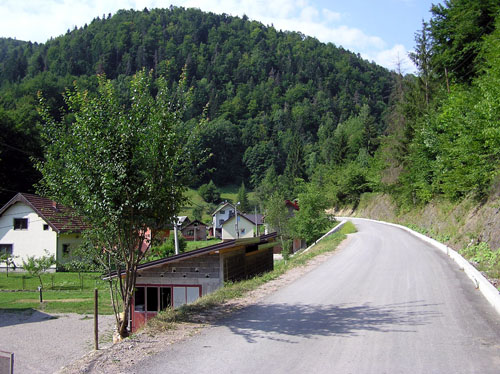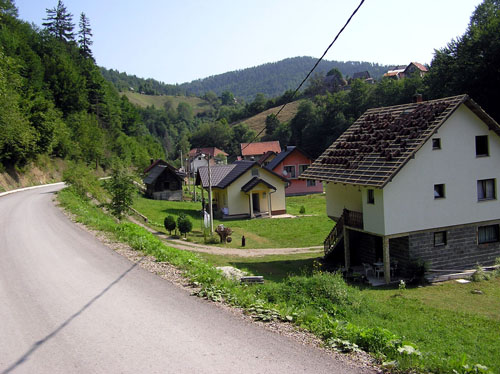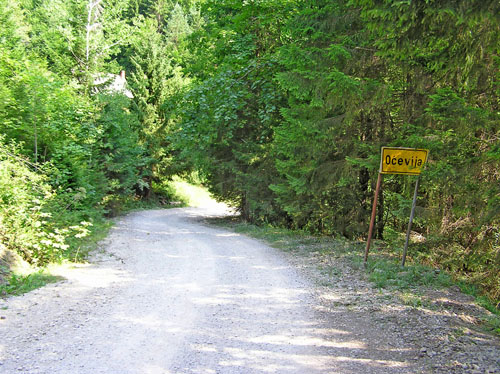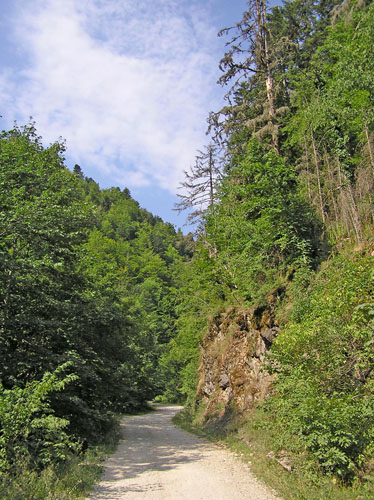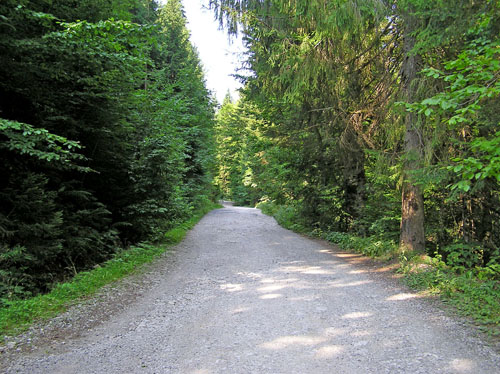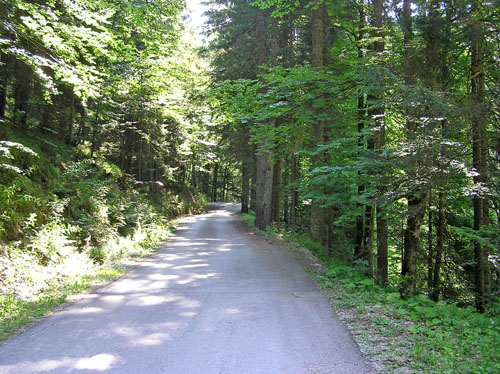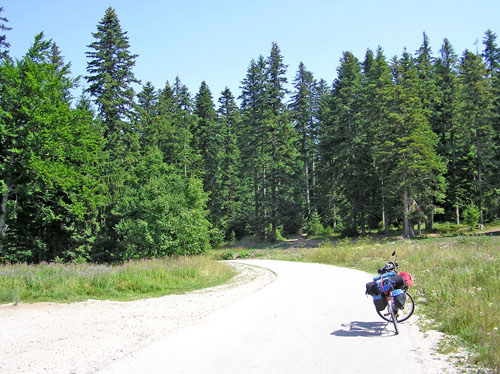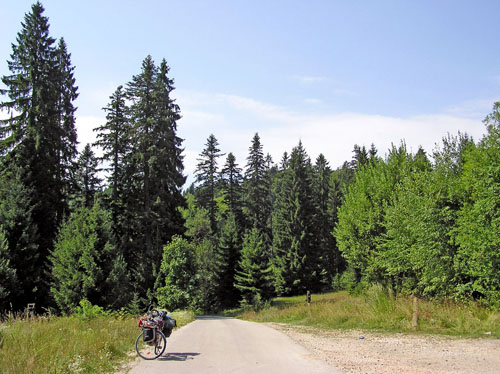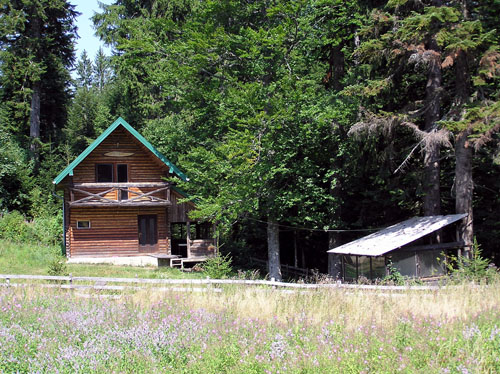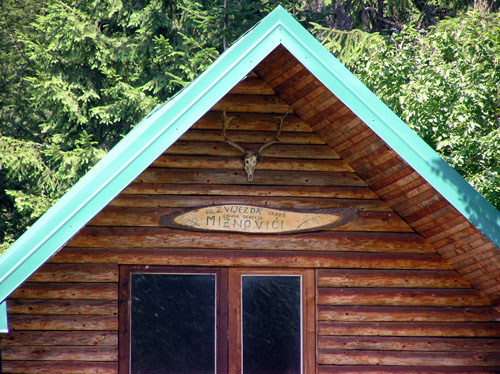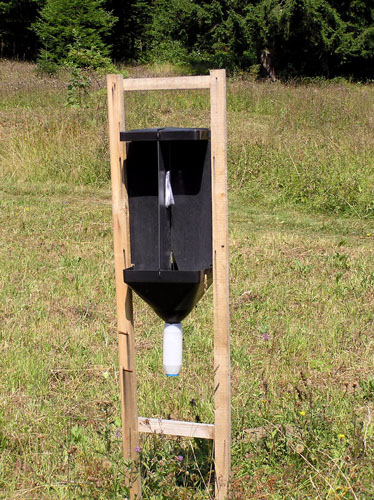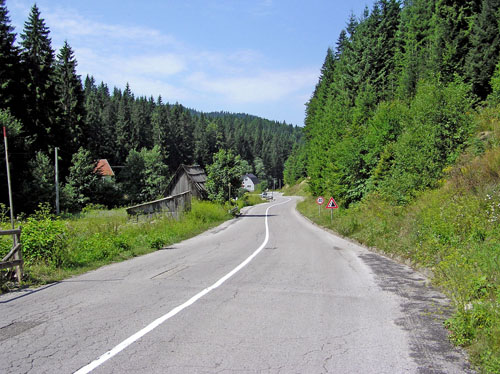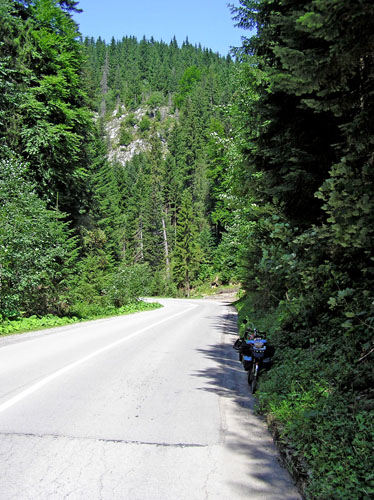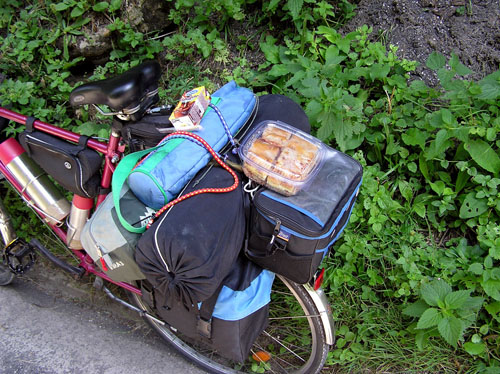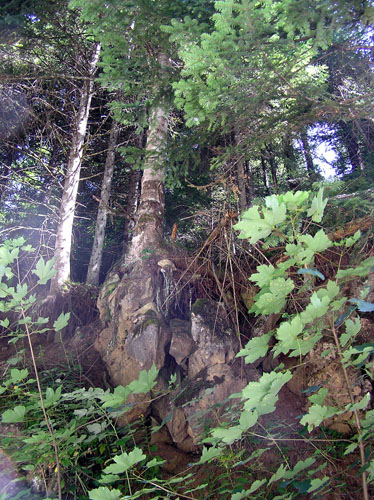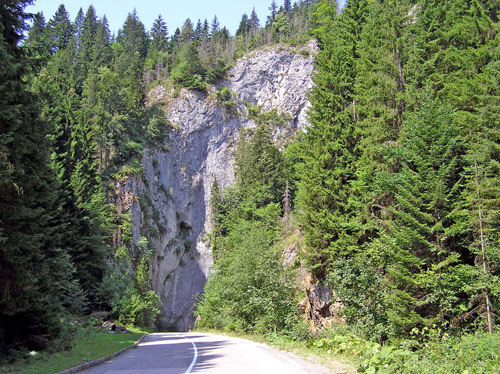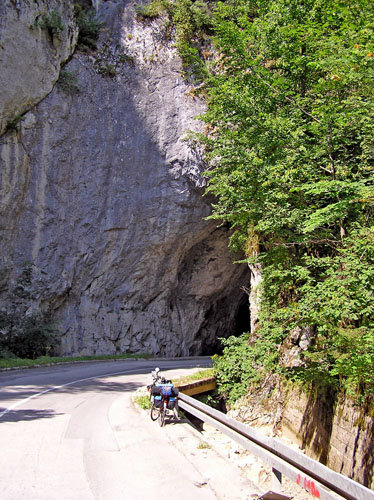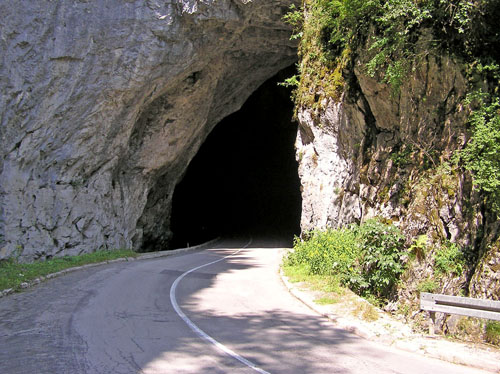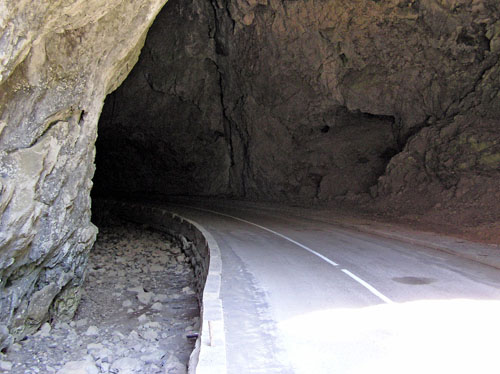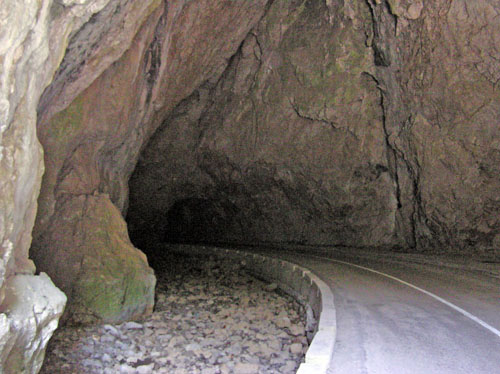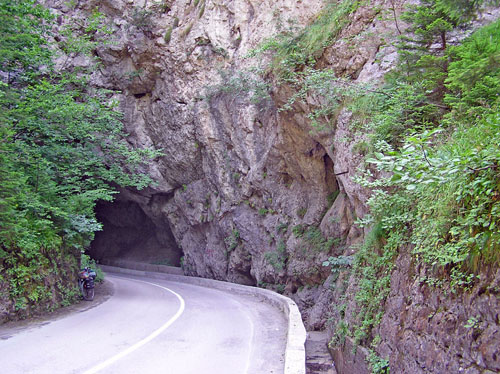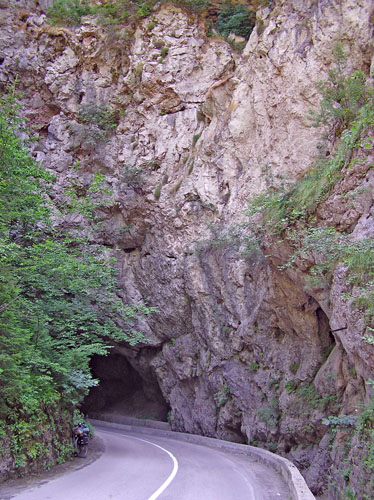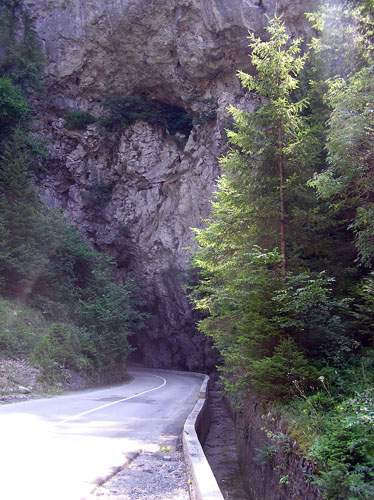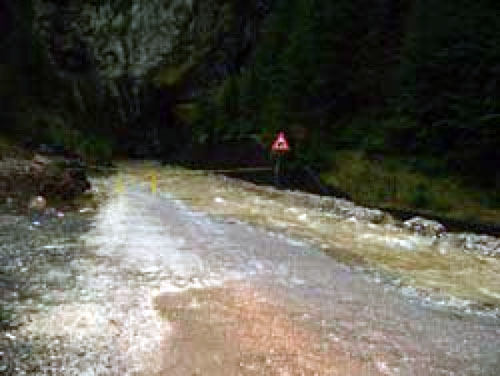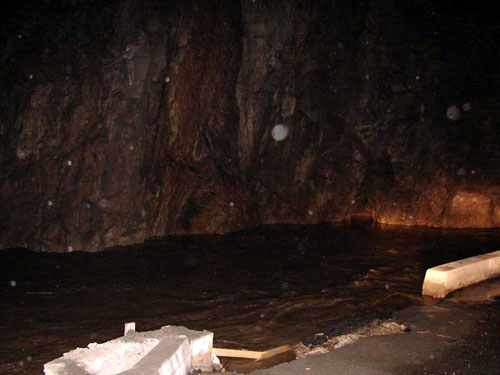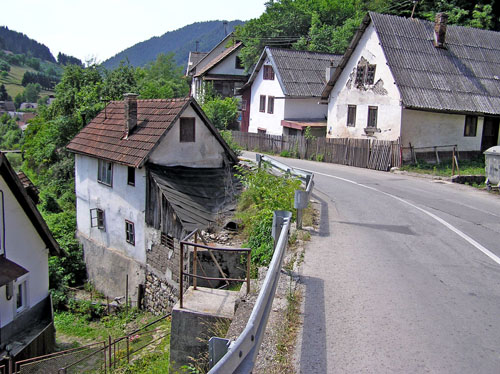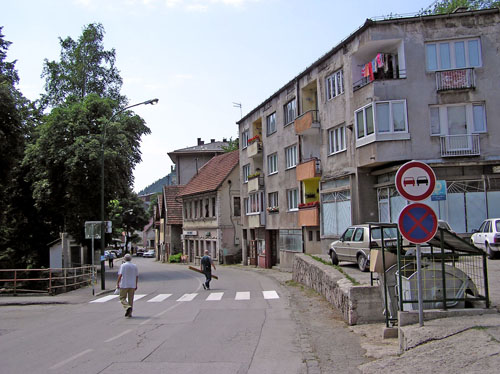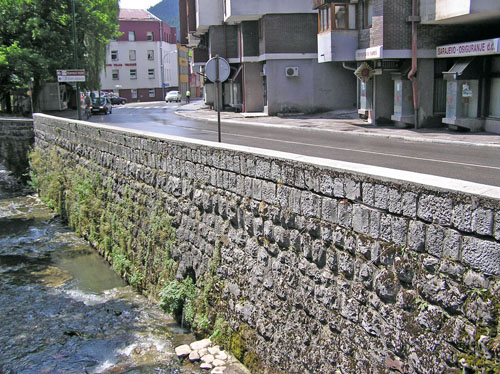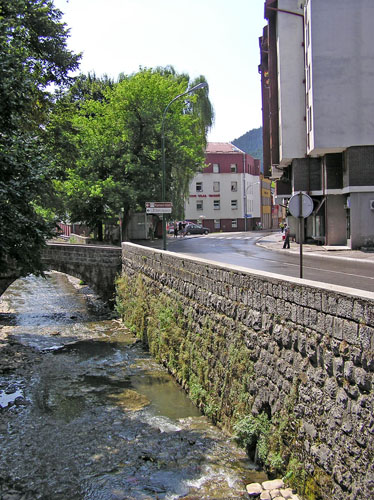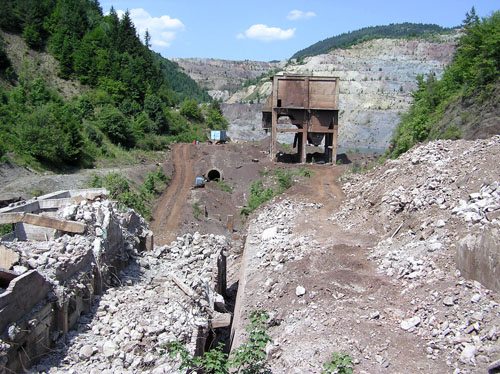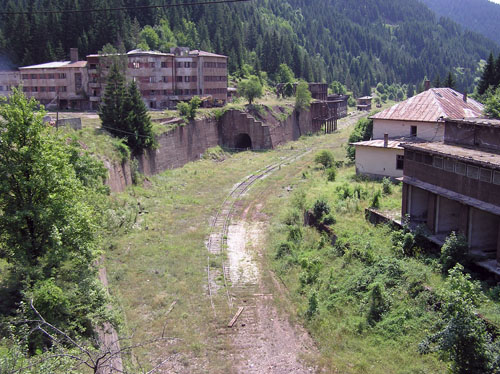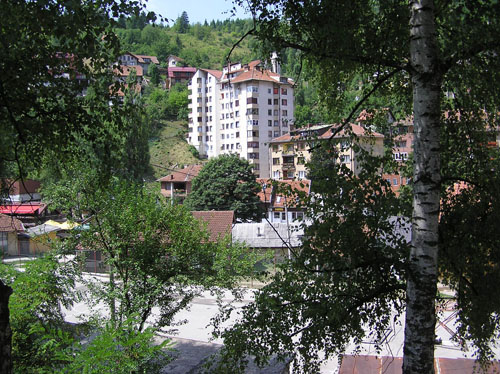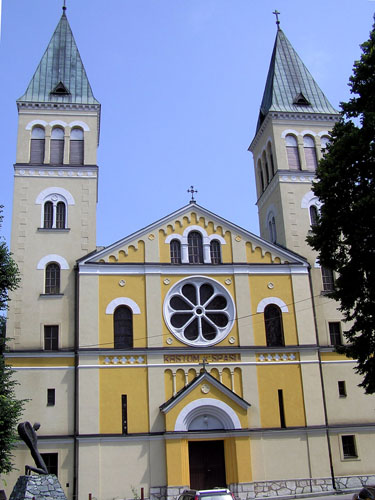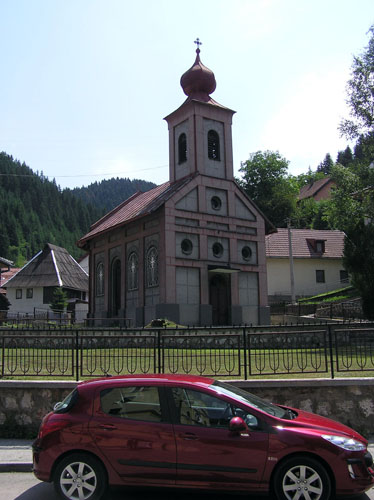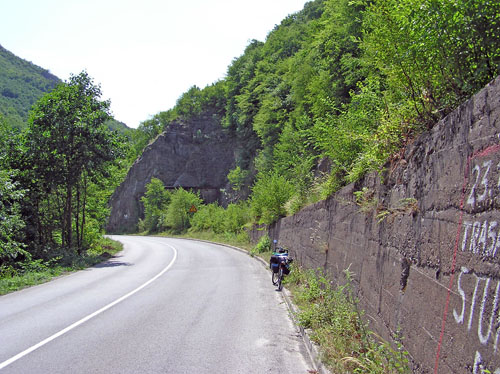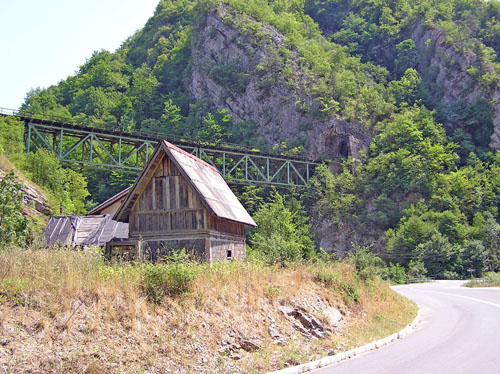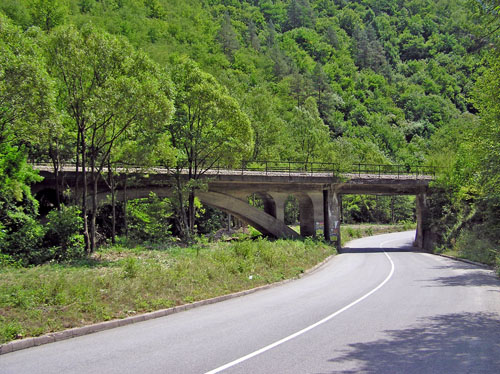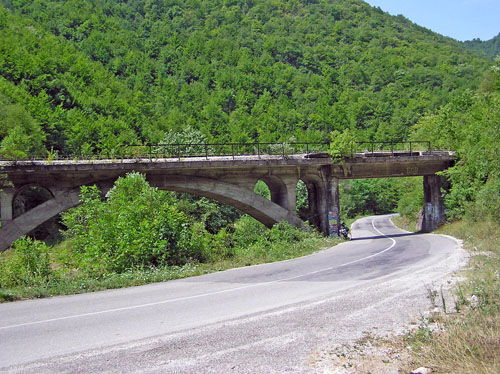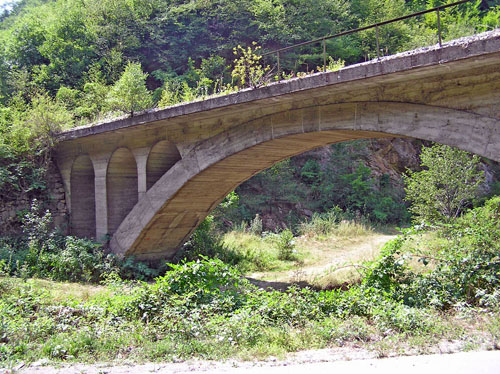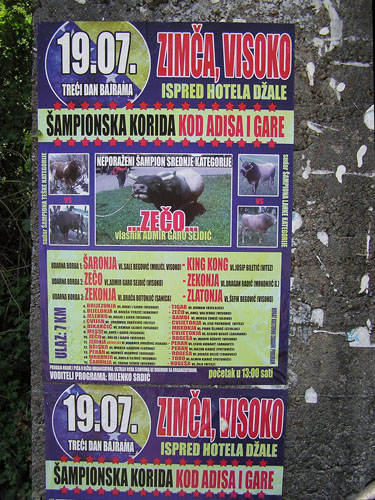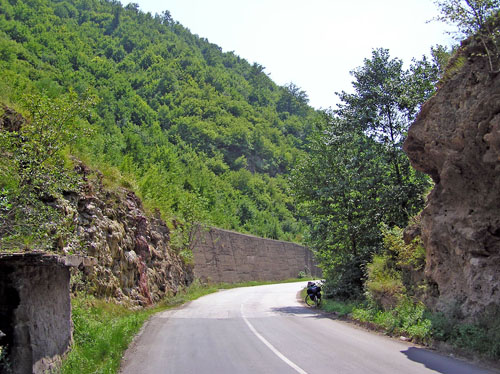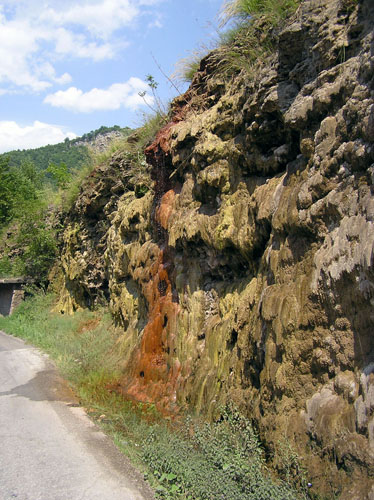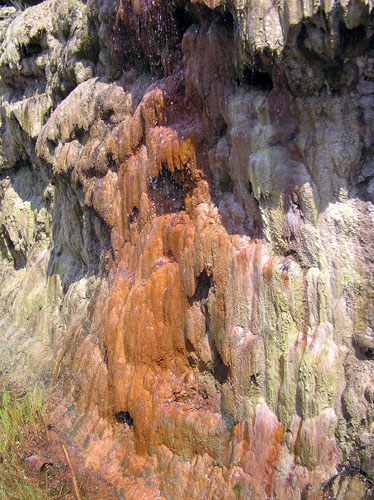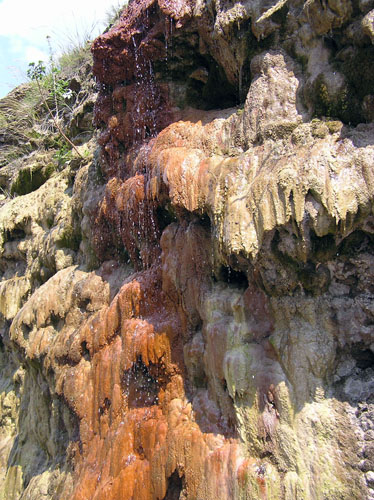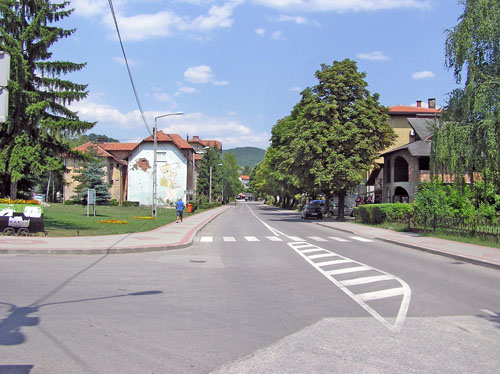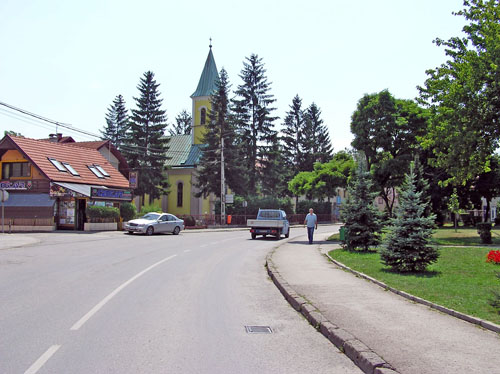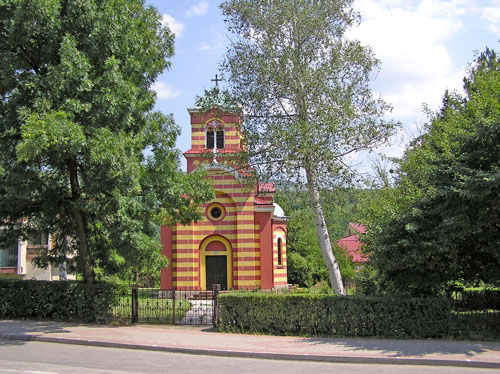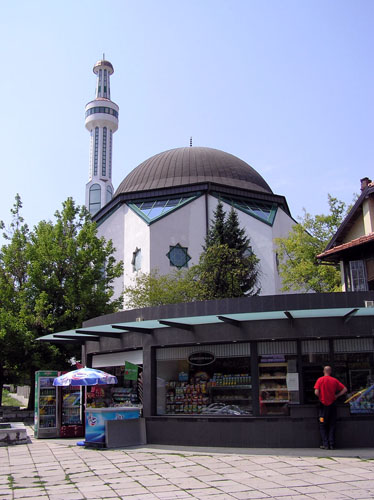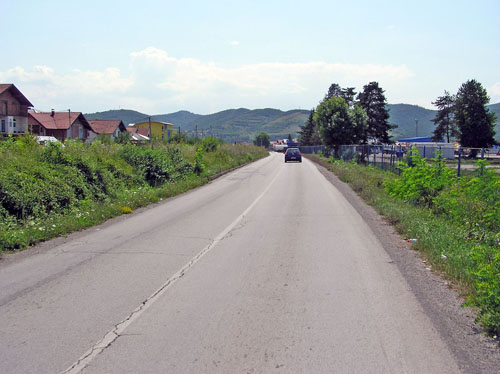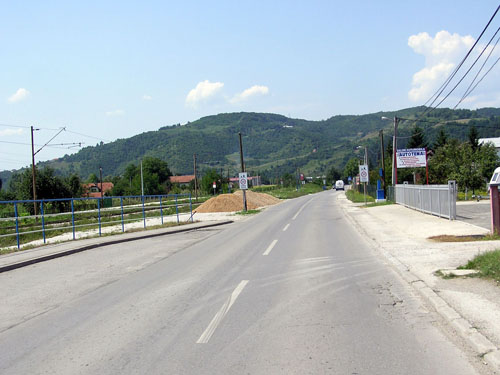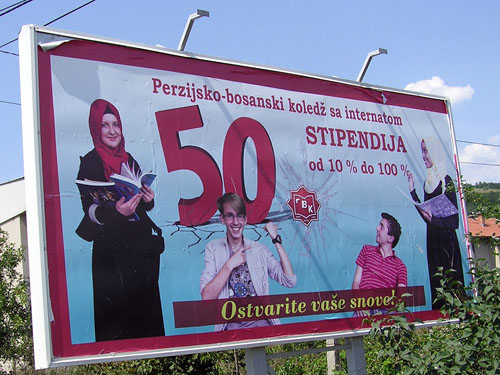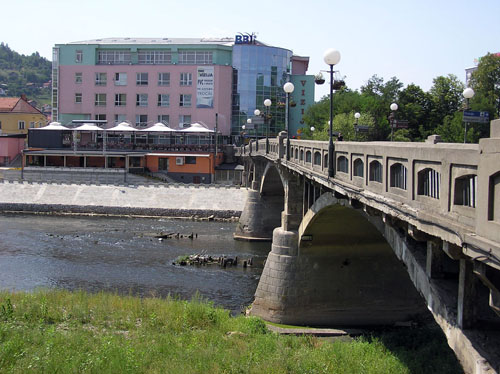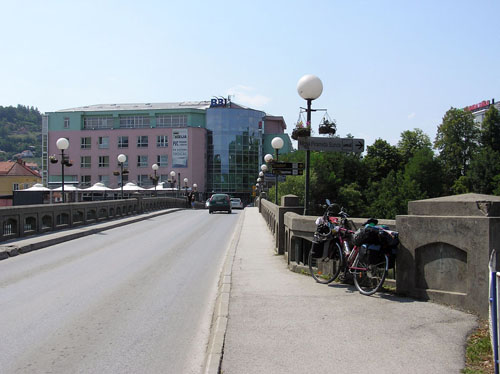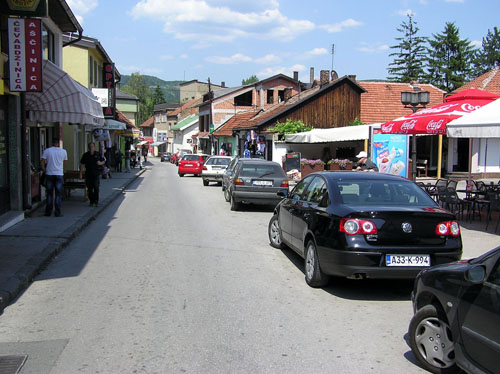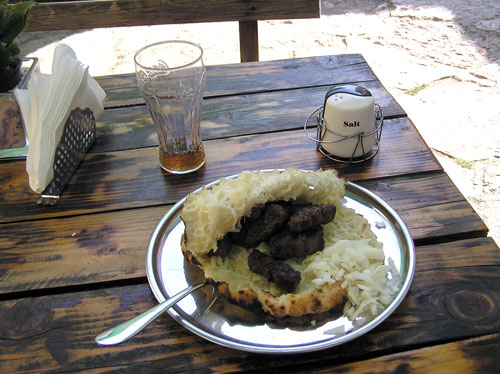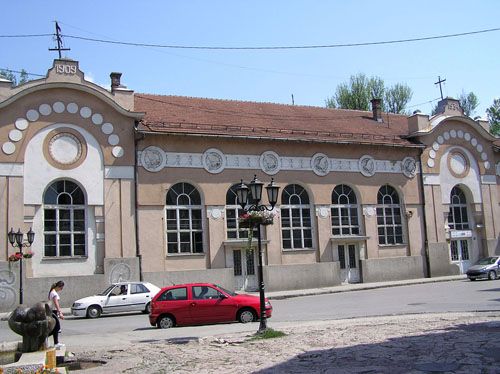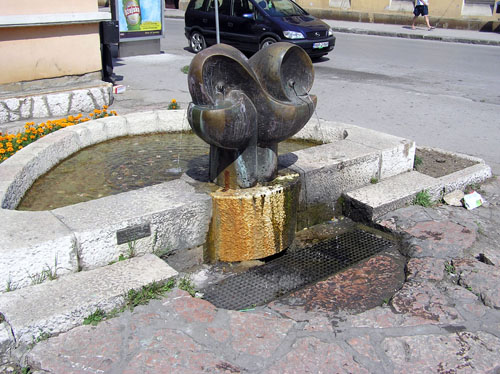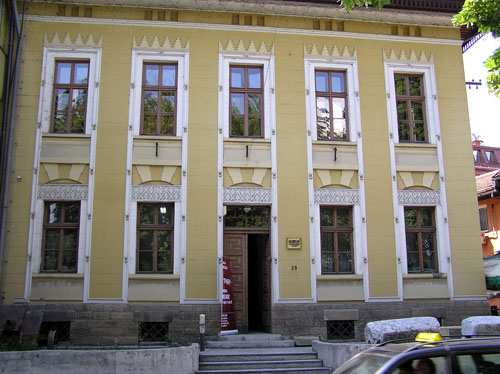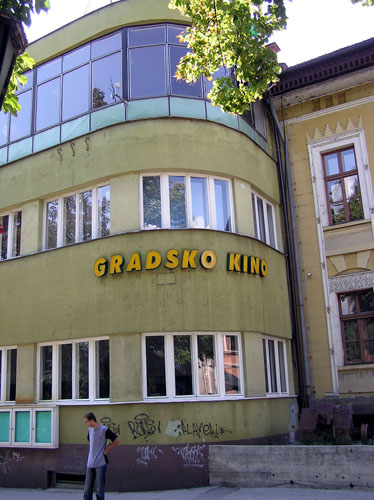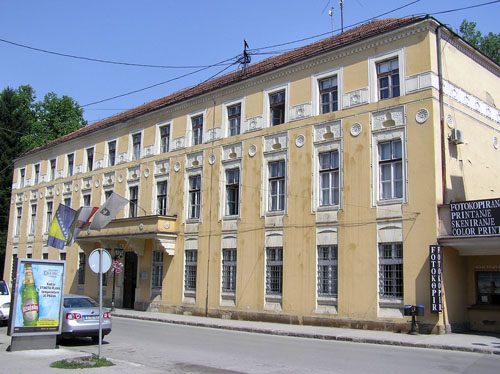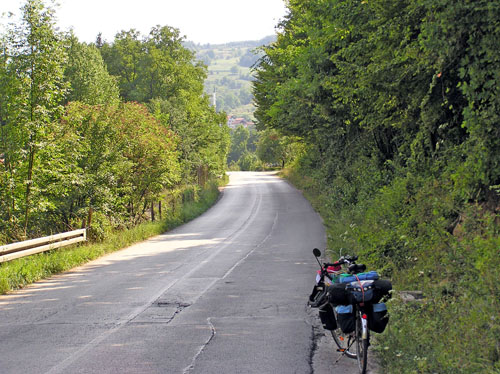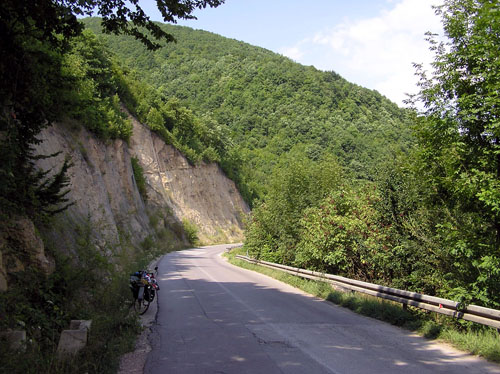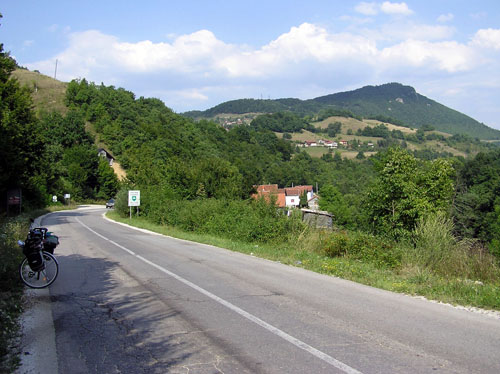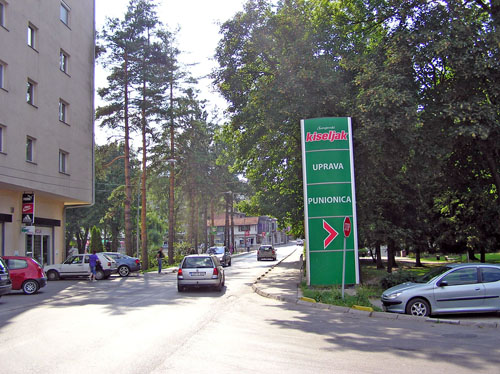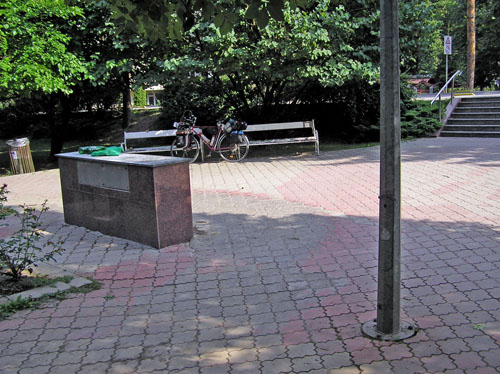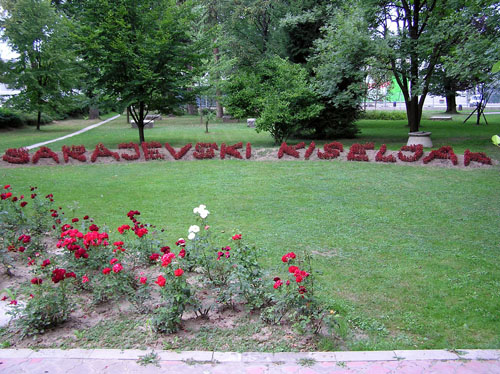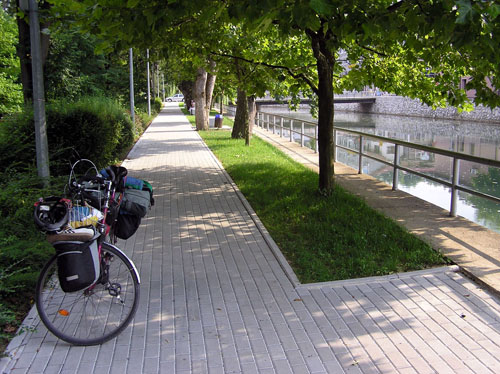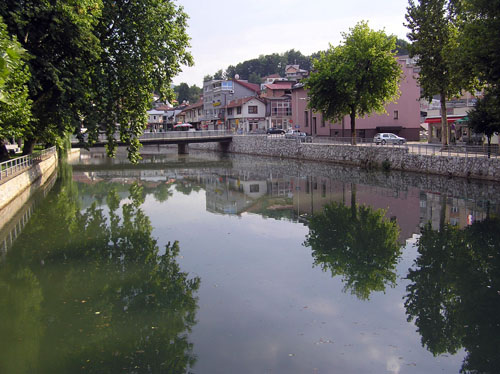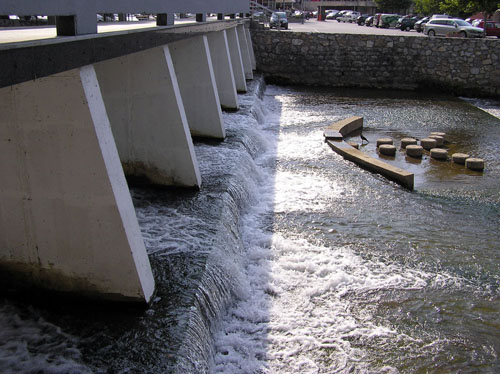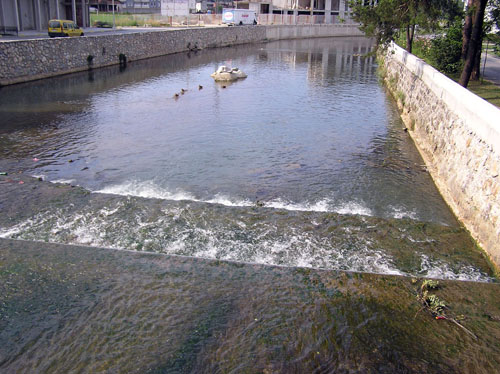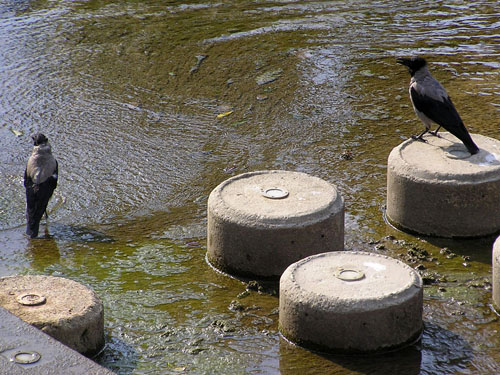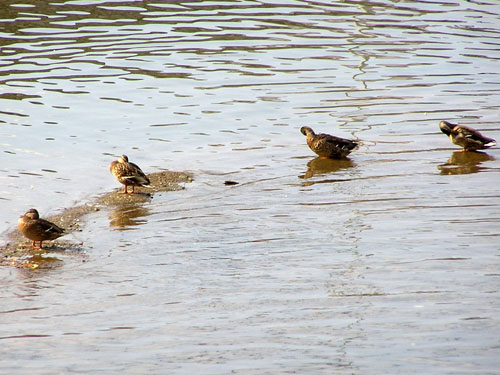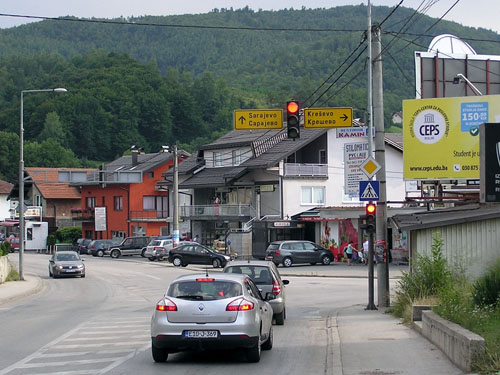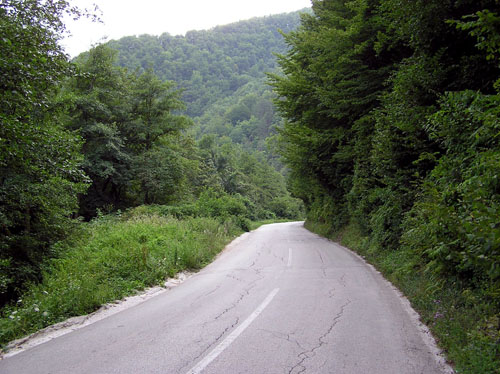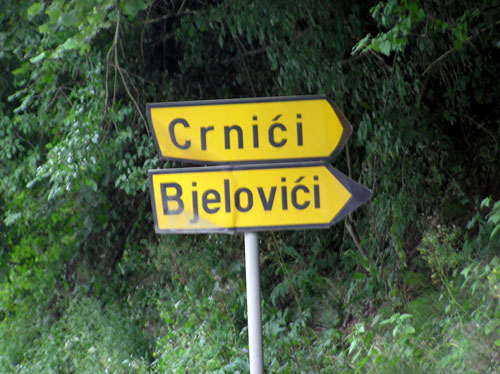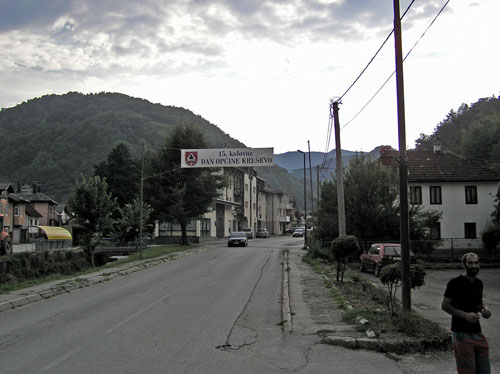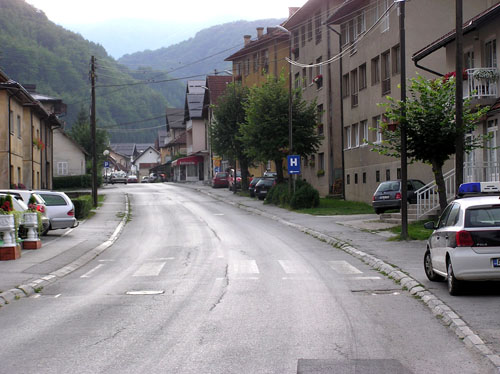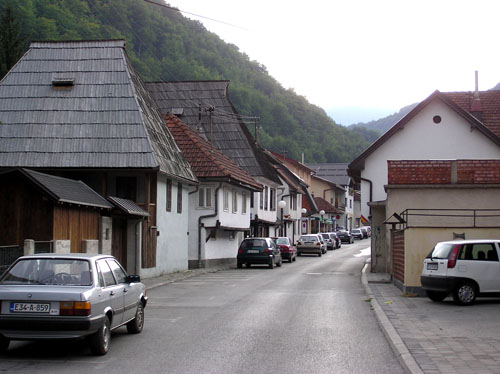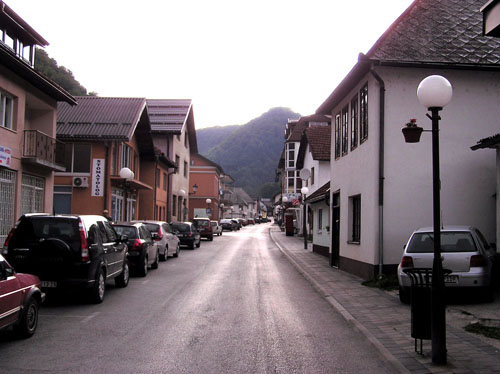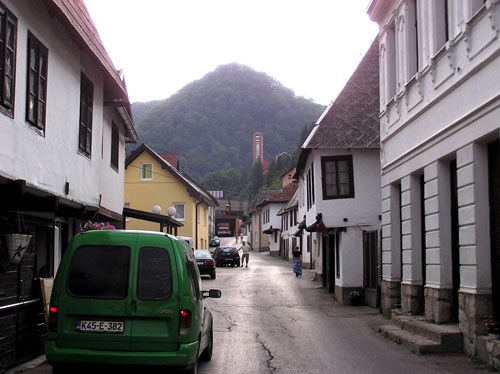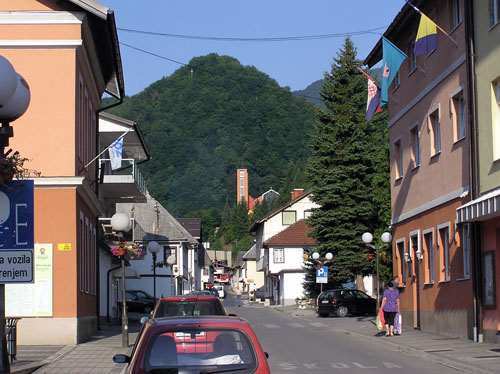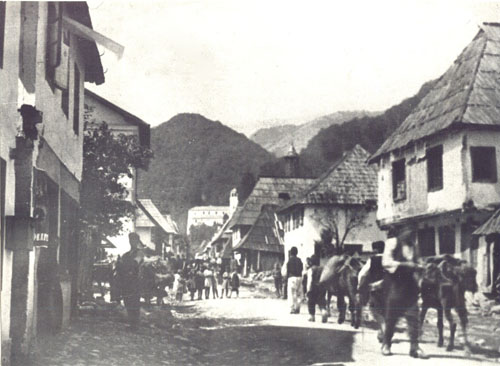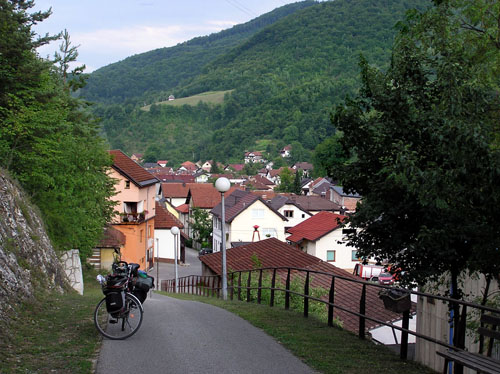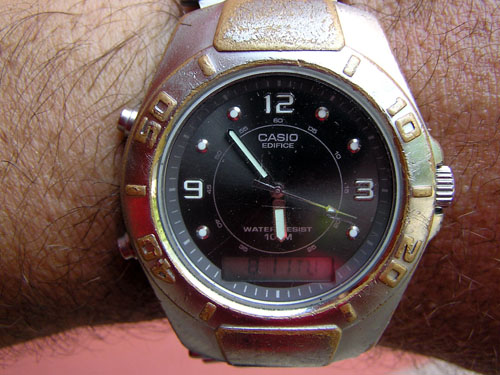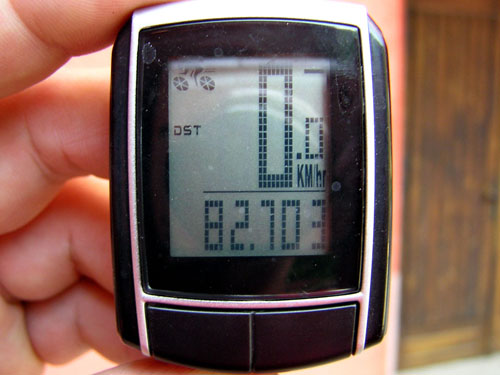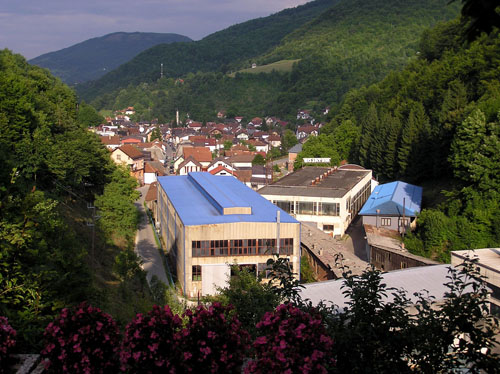Marketing
Alone in summer 2015 - Part One
The joke is the following:
The guy named Mujo had a mistress, Fata was her name. Fata was married and lived in an apartment on the top floor of the highest building in the Sarajevo town. And one day, while her husband was at work, Mujo came to Fata's apartment, with her went to the bedroom and they started work. Just when they were close to the ecstasy, suddenly the husband comes in the room. These couple in the bed were very, very surprised, even astonished. Given that Fat's husband looked like Arnold Schwarzenegger in the Terminator movie, all in the muscles, any form of opposition to him was inappropriate and even dangerous. Therefore Mujo has pacified himself, hiding in "the mouse hole", even does not breathe. Fata tries to lower the tensions, peacefully and flirtatiously, "Do not overdo it", "It is not what she looks like", "She only loves him, her husband"...While she is telling her story, he is silent, comes to the bed, pulls Mujo out of the bed, carries him like a feather to the balcony and throws him (!) over the fence.
In these few seconds, while Mujo unstoppable flies to the grayness of asphalt beneath him, all his life has flown through his head.
"God, I'm not sure if I really needed this!? I have a job, I have a good wife, I have children, I have a house, a car, I even have a cottage on the sea … And now, because of my nonsense, here's how I ended up ... ".
That this story continued to develop as expected, there would not be any story. But as it is already in stories, and unlike in real life, something unexpected has appeared.
In the same time down below Mujo, who unsuccessfully plays Superman, a tractor with a trailer passed and on a trailer was hay, a lot of hay.
Instead of the hard asphalt, our flying hero gently hit on hay, he bounces back, also gently, then again on the hay and then again into the air and finally touched the sidewalk, also gently.
For the first moment, he was confusedly surprised at this extremely unexpected overturn. Immediately afterward, he was unexpectedly satisfied that the journey to the other world was delayed until further notice. And in the end, our hero, very, very happy, continue a walk on the sidewalk. While he was walking, he was removing the hay from his body nonchalantly and he thought: "What kind of nonsense I think of when I am frightened!"
I had similar extremes in my thinking on this journey and beyond it. From the beginning, there was some difficulty with this journey. For some of them, I'm guilty, some of them seize to me without my influence, as a misfortune, like a bad fate.
Desires are that which destroying a man, I know that still from my youthful days. You have to watch on them, keep them under control. It is not good when they are missing, but it is also not good to exaggerate with them.
However, passion is much easier to give up than reduced it to a reasonable value. This statement, which I have heard long ago, during student days, constantly appears somewhere around me and in me too. I'm wondering all this time: How does that reasonable value look!?
Like after each, so is after last summer, I patiently bear the grayness of everyday life. I do all (or at least I'm trying) what is expected of me without a complaint. One of the sources of energy and patience is writing a blog, which you are reading this time. Parallel with this is the development of plans for the next season. Unfortunately, for me, I exaggerated with those plans. What is the reason for it, does not matter for this story. It is more important to me, personally, as a lesson created by experience, that in the future (a little more) I will keep to the plans under control.
And maybe the cause that makes impatience is my years. Impatience that there will be no time for the realization of (all) desires, as well as for the rest of the unrealized from the past years.
For example, for a number of years, the Martin Brod village on the Una river, as well as the waterfall of Kravica on the river Trebižat near the Ljubuski town, has been unrealized.
The human psychology is so strange, because how else to explain these desires and belief in their accomplishment. During the time, by intense and persistent self-persuasion, those difficult-to-reach, even unrealistic desires, gradually turn into something quite realistic and in itself understandable. I did not even notice some things were going on in the development of travel, mapping, mileage, collecting information from the internet.
First, the duration of the planned trip would be at least two weeks. Second, within those two weeks, there are days where it should ride on suspicious, even unpaved semi-roads, and at the same time with an exceptionally high difference in altitude.
And there was another problem - a companion.No matter how patient I was in finding and no matter how convincing I was in the coaxing, I could not find him. From the list that contained too many days, too many kilometers and excessively heavy part of the journey, everyone chooses what he liked.
I did not even start the journey, but I already had misgiving, fear, and even panic that there would be nothing about the journey. In the end, I was stuck in the corner course with two options: either not to go or go alone.
I didn't like any of these two options, so for days, I was in dilemma in this negative ambivalence - which one to choose.
I gradually tried to solve that problem with some sort of compromise. I will shorten the trip in half (the Martin Brod village on the Una river remains a wish again), and I will go alone.
(It was difficult, very difficult for me, and painful, very painful to make this decision.)
FIRST DAY OF THE JOURNEY
You can see the map of the first day of the journey here.
The pictures from the first day of this trip you can see here.
The surprising break of two years ago, when I was in the Očevija village (see Ochevia 2013), initiated in me a desire to continue my journey, where I stopped then. That is why I "hired" the same man who drove me from Očevija to my town at that time to return me now.
And finally, after all the problems and dilemmas in my soul, on a sunny morning from the Očevija village, I went on a journey. More precisely, I continued from where I stopped two years ago.
The wiew in front of me
The view behind me
I was impressed by the cognition that it had just passed two years since my last stay here in this village which is now in this beautiful, sunny summer morning. That two years seemed to me as one moment, just one small moment! And those moments we have only a few dozens in our lives. After that nothing, that's it!
Perhaps this is a sign of the crisis of the middle (or behind) years, maybe it is a reflection of unfulfilled (and excessive) desires, but it seems to me that the time passes in huge quantities leaving very little, almost nothing. I really need a lot of effort, trouble, doubt for that very little, almost nothing.
Nevertheless, after the ride, I have the feeling that I hold at least one grain from the abundance of that sand of time that is leaking through my arms. And some of these grain found a place in this blog, and probably this one, from this journey. If nothing but a sign, a mark of some time.
That morning when, as I already said, I finally started the journey, I forgot all of this, I moved all this aside that not bother me. I opened all my senses, both my heart and my soul, I left myself to the time and the area that I was passing through, and its impressions. Or shorter, I was happy!
By leaving the Očevija village, I left the asphalt
The narrow road and the greenness
Only a couple of dozen meters after leaving the last houses, the road has totally changed.
From the asphalted, quiet and flat road, it turned into a little wider macadam path, bumpy and winding which continues uphill. Later on, it will show that these uphill will be about 5 km. For comfort to me, somewhere on the half of that 5 km, asphalt appeared again.
Very quickly, just after a couple of dozen meters, I realized it was meaningless and overly hard to drive at this uphill. That why I was, in the style of "smarter giving up," came down from the bike and continued by walking. Slowly walking, my heartbeats returned to normal quickly so I could enjoy the "peace of God" of the area I'm going through.
The forest around me was thick and infinite. I had the impression that some birds tried to talk with me with its singing in a sign of greeting. No people anywhere or any sign of them.
Gradually, my enthusiasm with the peace and silence changed from idyllic to gloomy (everything was in my head), because there appeared a fear of meeting some of the beasts. Fear, mostly irrational, has taken on serious proportions. Because of that fear, I found myself that I am looking in wide open eyes what lies behind the trees in anticipation that someone will jump on me every moment, though I do not know who or what. I understood gradually, fear has taken a worrying amount, and for his neutralization, I need more than ignoring. That I found in - the cycling bell. I was confessed to myself that I did the good thing that I put the cycling bell on my bicycle equipment. Although I did "not even dream" for what all it will be used, now I would assume that it would also serve as a defense from the beast. Well, this "defense from the beast" might be a bit over-expressed. Anyway, using that cycling bell gave results. I do not know if I was defense from the real beast, but I know that it helped to overcome my fear of them. And so, in the continuation of the journey, every time when I felt discomfort again for someone that would surprise me uncomfortably, a few ding-dong, and the idyll of enjoying in the ambiance came back again.
Again asphalt
As I said after about 2.5 km asphalt appeared again. I did not ride too much, only in less uphill, cause even walking made easier and faster. Still, pushing a bicycle by a flat hard surface is one and pushing it over the stones and rocks that insidiously peek from the ground, is something quite different.
I feel the need to point out that I started the journey this morning relatively late - just before 10 am. The reason for this is my desire not to offend the hosts who did not allow me to go on the journey before breakfast. That breakfast was stretched, though I waited patiently, which was not a problem because I had a pleasant conversation with household members and neighbors. Besides, though late, I started the journey with a full stomach, so I do not have to worry about food for a while.
The summit of the pass - where am I going to
The summit of the pass - where did I come from
After an hour and ten minutes from the Očevija village, I reached the pass. Its special feature is that it is not in the forest, through which I have been going all the time, but on some kind of glade. The glade is not a big one, on the contrary, because from the pass the road goes to the forest again.
Hunting house on the summit of the pass
At the summit of the pass, is a beautiful hunting log cabin, pulled off some 20 meters from the road. I find out this by reading the sign on it.
The sign tells:
LG "Zvjezda" Vareš
Lovna sekcija
Miznovići
What means:
LG (I suppose Lovačko gazdinstvo = Hunting Farm) "The Zvijezda Mountain" (Zvjezda = Star) The Vareš town
Hunting section
The Miznovići place
The Totalizer
On the other side of the road, only two or three meters away from it, there is a pluviometer that measures rain amount and other precipitation. By browsing the Internet, I found that the outer container has a precisely defined opening (usually 200 ccm). The rainwater collected in the inner vessel is flowed and measured in measuring jug (divided by a millimeter of precipitation height). Snow should melt before measuring. Measurements are performed daily at 7 am and at synoptic stations every six hours. In the inaccessible mountains and uninhabited areas (as here) are placed totalizers. These are the big pluviometers where precipitation is accumulated over a longer period, usually six months or a year. They contain chemicals to prevent vaporization.
Obviously, this one I met was one of those totalizers.
The Beauty of the Zivjezda place in the Zvijezda Mountain
After a mile and a half, I went out on the "true" road where I turn left after some time of indecision. The indecisiveness is the result of excessive enjoyment and relaxation in the environment, which has resulted in the absence of a notion of time. Though this morning the hosts, at whom I spent the night, said that I would come to this road and I need to turn left, all of it happened to me suddenly.
The road on which I continued driving after the turn was a road what road should be - wide enough that two trucks could if need be, pass without problems, and in the middle, it had a prescribed line. Well, actually, it was pretty curvy, so there were often speed limitations at 40 km/h, but this did not bother me on the bike, on the contrary!
And the environment is like a fairy tale! The place was called Zvijezda (Star) as the Zvijezda mountain at which I drive from this morning. Houses scattered, there were even people who work around the house. Both these houses and the roads clenched in a narrow area pressed by coniferous forests on both sides. It was only 11 am, so morning freshness with all the mountain fragrances was still present. A rare, unique, and worthwhile experience that is deeply has been embedded in memory although I'm not aware of it. And I will be aware of it when it comes to my consciousness much, much later, causing a loss of understanding of time and space in which I will find myself then. At that moment, shorter than a second, but very peculiar and powerful, I will move to this greenery, in this smell, in this light, andin this time.
Short break
Consuming of the pie
After the Zvijezda place was followed a mild, curving downhill through the mountain ambiance. In one of the small shadows, I paused for a short rest. As I watched the ambiance in which I stopped, I remembered the fruit pie that my wife had prepared for me yesterday.
Chewing the delicious pieces of the cake, I observed, as I said, the environment, and my view was over the bicycle were one tree demonstrated a struggle for survival in this area.
Fight for Life
And then I came in front of the tunnel.
Although it is not visible, it's somewhere here - the tunnel
Although it does not see immediately, the huge, perpendicular grey rock in which the road goes will appear in front of me. And the tunnel is here, too. I knew him, heard from the host story this morning, tried to look at it on Google Earth, but it was all nothing. Despite the information and search on the Internet, I was surprised by its appearance. Nothing, I say, because only when I come to the place I get a real impression of it, and only then I realize how a little I know about it. And I was wrong when I thought that I know a lot.
Entrance to the underground world
No one tunnel so far, and I rode through a lot of them with a bike, did not cause me such a particular impression as this one in front of me. In front of me, a huge vertical rock in whose darkness, also rocky, without concrete, the road disappears. Like it swallows it devouringly. Around me, the silence, the heavy, the gloomy, and that little bit of sound like it's coming from somewhere deep down below (or from) me. I smiled to myself sarcastically when it seemed to me that the rocks above me were moving to get me into itself. Although the sun radiated more than enough, I was shakedown by the feeling of anxiety caused by the ambiance.
Oh, did I frighten about this tunnel?
The impression was reinforced by a lifeless creek that, along with the road, disappeared into the black tunnel.
There is no any vehicle, anyone from this world, to bring me back to reality, to strengthen me, to show me that that the darkness in front of me does not lead to the center of gloominess, that behind this blackness there is a light, this one that is now enlightening me.
"We have to cross the river!", I said to my bike, I switched on the rear flashlight and the front LED lamp, and by holding on to their light as a straw of salvation, I entered into the blackness.
The entrance to the tunnel
Notice the water-dry creek by the left side of the road
First, immediately at the entrance of the tunnel, the road turns sharply to the left, causing that the daylight behind me extinguish unexpectedly quickly. Secondly, full darkness extinguished the eagerly anticipated light at the end of the tunnel in front of me, the darkness that is rarely experiencing, the darkness which was enlarged by anxiety and fear felt in the soul. My little LED lamp shone with such a low light in front of me that I was able to discern only a pale line on the road from the darkness around the edge of the road, and then in the middle of it. I realized that I was roaming zig-zag in the total, absolutely total darkness.
I was blind!
I realized that I could not go any further like this. I stood by the edge line on the road and with my right hand, I started to find light generator on the front wheel of my bicycle. I did this with blindly groping because it was full darkness around me. I succeed to find that light generator and I turned on it by one "click". That "click" told me that the roller of the light generator clenched to the tire of the front wheel. Well, I've turned on added extra light, now I just have to start riding the bike.
Just when I thought that nothing worse than this groping along the bicycle in the total darkness could happen to me, the sound of the upcoming car behind me ominously and maliciously said to me, "Yes it can!"After the sound, weak light beams has appeared. The only thing left for me is to squeeze by the right side of the road. I even tilted to the right as much as I could, with the confidence in the rear flashing red light on my bike.
Obviously, that power of the rear light was more than enough, because the car was bypassing me in a wide area. Standing so slantwise in anticipation of the car, I watched in front of me how the black, dark, sinister darkness transforms into the contours of the rocky and wrinkled interior of the tunnel. This rocky and wrinkled interior seemed to me like a pharynx of the giant, weird beast that is swallowing me and this upcoming car too. Moving of the light, as a result of the motion of the car, has revived this pharynx, and it seems that it move ravenously to devour a delicious bite.
I watched the red light of a car that leaving from me. When total darkness surrounded me again, almost I felt relieved, still experiencing that pharynx in front of me. Still, this darkness is not so bad. I started the ride, somehow calm and serene, as if this darkness around me was whispering, "I'm nothing, you're afraid of me!?". The light generator started to buzz, the light came up on the lamp (those driven by that light generator) and I finally saw in front of me the road sufficiently illuminated. A little increasing the pressure on the pedals, the bike below me accelerated, and the light were also amplified, so now, besides the road in front of me, I was clearly seeing at the rocky contours of the tunnel.
Around me peace and quiet again. Fascinated by what I saw in front of me, I felt in my soul pleasing gratification. I found myself that I enjoy in this ride, in which all mysteries, anxieties, and fears disappeared completely. Seeing in front of me the trace of light that telltale reveal the end of the tunnel, I felt a kind of a disappointment that this enjoyment does not last more.
Here's what the man is! I entered the tunnel with discomfort, anxiety, even fear, and I came out of it with disappointment because of the sudden interruption of pleasure. Not knowing how to explain this, I will shape it into another victory over the greatest of all the enemies I encounter - with myself, or more precisely, with my irrational fears.
One week after returning home from this journey, in a store I bought the front light for the small money, just what I needed in the tunnel. On its box has been written that its light intensity is 20 lx. If it lights up 20 lx, then my little LED lamp, here in the tunnel, does not have 2 lx.
As I do not believe much in coincidence, I attribute it to the One who has rewarded me for faith in myself and Him when I was passing through the tunnel, and in the end, as I already said, for one small but important victory over this "greatest of all enemies"- my inner irrational fear.
The exit from the tunnel
Otherwise, local residents are proud of this tunnel in some way, because there are only five tunnels in the world like this one is. It is a natural tunnel that long ago broke through the stream of the creek so that the men would only later spread it so that there were more places for the road by the creek.
Now it is summer, so there is no water in the creek. But in the winter or early spring, often the water floods the road so the tunnel is closed for traffic.
Flooded tunnel (images downloaded from www.http://radiobobovac.com)
About a hundred meters after the tunnel, the road turns to the left and curve up in a short but steep downhill. The steep downhill passes quickly, replaced by a slight downhill.
Soon after the first houses of the Vareš town have appeared.
Now while I am writing this text after the end of this journey, it seems to me that this house on the image above, which squeezed along the left side of the road, represents the actual condition of the Vareš town.
Firstly, it is located on so steep terrain, so that the left side of the house is even on three floors, and on the right is only a few inches from the roof to the ground, although the house is not too wide.
The secondly, black roof, now half collapsed, and windows with broken glass, or those who do not have a glass at all - all say that it is questionable whether anybody in the house currently lives. And if they do, then they are much less than once before, when life in this place was brighter, easier and more vivid.
Third, lush greenery around the house as if it was the only bright side, it is solely that did not reduce its intensity of living from the better days to this day.
So, the town itself is located along the river, better to said along the creek named the Stavnja creek. Along the creek there is barely enough a room for a road, let alone for houses, not to say the town. And the road, along with the creek, goes downhill, so if I did not brake deliberately, I could go through the city without seeing anything.
And what I saw was not very bright and cheerful.
There are not too many people. Also, there are no too many stores, and they are mostly closed and rusty. The facade buildings are decrepit.
I stopped on a stone bridge over the creek with intending to photographed the city. As I photographed by the camera, I felt in the air a weird smell, some kind of putridity, garbage or something similar. Perhaps the creek was passing through some sort of garbage landfill before the town, maybe there was somewhere near garbage, and maybe it seemed to me like that. Was it seemed to me or wasn't, it doesn't matter anymore. It is important that I feel that this city loses itself, disappears, sink ... dies, no matter how many people are trying to do the opposite.
It is hard to find the building with a renovated facade. On the buildings, a lot of very tightly closed windows, so tightly closed that they had not opened for a long time. Such windows keep the silence of the interior in which there is no one.
I heard earlier that this city is in disintegrated, but one is to hear and the other is to watch the town and feel it with all my senses.
According to the Internet, the town is located at an altitude of 829 meters in the Stavnja creek valley, 45 km away from Sarajevo. Above the Stavnja creek valley the high, steep hills rise on both its sides. This type of relief is inconvenient to develop a larger settlement on it.That is why it can only spread here along the north-south direction. The town of Vareš is a very rare example of a large settlement, which is stretched like a ribbon of five kilometers long. The area of the city of Vares has a mineral resource, dense forests all around and large amounts of water. It is estimated that there are over 150 million tonnes of iron ore of medium quality in the Vareš town hills. This was about half of all the stocks of that ore in the former Yugoslavia. The surroundings of the city of Vareš is abundant not only with iron but also with other ores, containing lead, chrome, zinc, aluminum. Before the last war, Vareš was a powerful industrial center. The iron ore mining unit employed 1180 workers, 890 ironworks, 630 wood processing, 750 forestries, "Vranica" - construction company Bobovac 490 ...
Of all of this, today nothing or almost nothing. The war in cooperation with wild privatization all dispelled it. After privatization, what could be taken and/or sold was gone. The only thing that left is bare walls in the form of a ruin which are witnessing about the past and the present, and most of all about (some) people and their consciousness.
The Apocalypse Now
I photographed the top images on the southern outskirts of the town. As I watched the landscape, I felt that cold creeps passing through my body and provoked the trembling, even though it had already been noon and the sun was heated fiercely. A true post-apocalyptic scene like in Mad Max movies. The scent, the one from the city, remained in the air, something even more intense, the smell of the hopelessness, the smell of the despair, the scent of indifference, the scent of the complete ruin of man.
Otherwise, it remains unclear to me how somebody in this terrain created the city. The only justification is a profit because this area simply has no place for such a peaceful life.
The hills, both steep on both sides of the narrow creek valley, were house destinations.
While I was resting in front of the Catholic Church, one building-house attracted my attention, which built in some of the better, brighter times of this town.
The building has 7 to 10 floors, depending on which side of the steep hill I watch it. With a bit of imagination and maths, assuming there are 7-10 apartments on each floor, I'm coming to the figure of about 60 apartments in the building. Suppose there were two, three children in each apartment, we coming up to around 150 children in the building. Where they were playing and having fun? Where have they been spending something what is called a happy childhood, and what silently, inconspicuously, but decisively, to the core, determine it what we call the character of an adult man!?
Parish church Sv.Mihovil Arkanđeo (St. Michael archangel) in the Vareš Town
According to the internet, the parish of the Vareš town is very old. It dates back to the 16th century, while the town itself dates back to the end of the 15th century. The birth books are from 1643. The new church in Vareš was partly built in 1854-69 and is dedicated to St. Michael Archangel. One bell tower was erected in 1886 by Josip Vancaš project. In the same year, Marko Antonini decorated it with the figures of saints, and geometric and plant ornaments. The main altar, Tyrolean origin, has also been procured for those years. In 1977, began its reconstruction and was completed by 1981. At that time in the church, according to the drawings of the painter Josip Bifel, the stained glass was made, including one rosette.
So I stood in front of the church, bathed by the sun, and left myself to one of the few pleasurable impressions on the way through this town. Although it is not too big, the church gives me the impression of calmness, dignity, and ultimately, faith, so much needed for the inhabitants of this city, both in the stormy past, so today. Especially today! Those difficulties from history, no matter how hard they were, it has gone into history, while these present difficulties are ubiquitous, they are pressing, they hurt, and they do not let breathing or living. But a man must live!
A sight was typical of Bosnia I saw across the Catholic Church. It was an Orthodox church, though smaller, it was also beautifully decorated.
Orthodox Church in the Vareš town
I continued my journey in the desire to rest from the anxiety that has sat on my soul while I passed through this unlucky town. I say unhappy because with the richness of forests, water, and mineral wealth it has all the prerequisites for growth and developing, but it dies. The climax of irony is the news I read on the Internet so that the town could make a lot of money by renting former ironworks as scenery for shooting apocalyptic films, but it is not allowed. All of these scenographies are, in fact, privately owned, and the town can not dispose of it without the permission of the owner. But the owners are somewhere far in the world, enriched by the sale of facilities from this city, and do not want to remember the origin of this wealth.
Today's my goal is the Kreševo town, and to get to it I need to pass through the Breza town, the Visoko town, and the Kiseljak town. So a long road is in front of me, and it is already 1 pm. But, the time that my watch shows is not worrisome to me.
I am worried about the weather. Though it was 1 pm, the sun was shining very strong. It was hot, very hot.
Although it should be downhill, so my roadmap told me, I suspected that there were some technical problems with my bike. True, there were technical problems, not with the bicycle, but with the hot south wind that was blowing in my face, negating the advantages of gentle downhill.
The road I drove was quite well, quite enough widths, the asphalt is not bad.
From the Vareš town to the Breza town
I already said before, that the road goes down by a gentle downhill, a winding along the Vareš creek Stavnja. The standard gauge railroad track was a companion to both me and the road. Unfortunately for me, the lush greenery and the surrounding hills mostly hid this railroad track from my eyes. It will only occasionally emerge in the form of a retaining wall or a bridge over the river and the road. I feel a little disappointed because as I watched the roadmaps at home, I expected more exoticism. That disappointment was accompanied by the feeling of anxiety caused by the absence of trains. In fact, this anxiety is the result of the knowledge that the train has not passed this line for years, and it will not anymore. So, I was not anxious that there were no trains, but I KNOW that they do not go anymore, nor have they been going for years.
With all that, I still have to wait for a long time to meet someone on the road. So that general anxiety from the Vareš town spread to this road. Empty road, dead railway, monotone, sinister, hot breeze (straight in my face) dense greenery that all hides, and lonely I, like I am alone on all of the worlds. That feeling of loneliness has multiplied by the arrival of the escarpment on the road in front of me. There was some dusty, improvised tour around the escarpment. But it seems to me that the escarpment and its tour around have not been from this summer or from last winter, but from a long, a long time ago. That is why the improvisation solution remained constant because it was realized that for such rare traffic was just enough that solution.
The escarpment and its tour around
As I swirled within my anxious thoughts, with the feeling of abandonment from a people, just while I was riding on this dusty improvisation, a truck emerged from somewhere and put me in a totally dense cloud of dust. It showed me that being alone (with these thoughts) is not the absolute the worst and that it can always be worse. (By the way, long, long time after this there was no anyone vehicle on the road).
That silent companion, railroad, its trip to the Breza town often went through the hills, by tunnels, and also it crossed over the road and the river beside it by bridges. These bridges are mostly of the same type except one.
Railway bridge which is an exception in compare to the other
This exception bridge is a metal, grid construction. It's by the roadside. It is made by going the railroad from one tunnel to the other.
The others are made of concrete, they skip the river and the road simultaneously, and they are of the same shape and construction.Similar bridges
A look from another point to another bridge
Careful eye with patiently looking will notice the lack of part of the fence on the last image. This, as well as the appearance of a fence that was lucky to remain not stolen, tells pictorially that a lot of time, not to say years, has passed since someone to do maintenance, that the bridge, as well as the railroad line that goes over it, still had some sense of existence.
That there is a strange, ironic, even morbid meaning of one of these bridges at present day, tells the advertisement which is glued to its pillar.
The bullfight advertisement
When is present happiness and prosperity, people have the need for fun to celebrate the state they are in. When it is a crisis and hopelessness, it is a need for consolation that people have at least a moment to forget the gray of everyday life. So also this poster, whose existence the railway bridge indirectly allows, invites every citizen to the championship bullfight. There, with the help of bulls that are mutually butting, crowded helped by, probably, too loud folk or "folk" music, with a good meal also with the abundance of alcohol, can at least for a moment get away from the torments, the misfortunes and the problems for whose solution they have already lost all hope. Because bearableness without hope becomes unbearable.
The sun warms on the maximum, the warm breeze in the face, nowhere anybody, I'm alone with myself. I spin pedals, bicycle drives noiselessly, I am looking to the left and to the right on the hilly greenery, thoughts wandering who knows where, when ...
I paused for a moment, parked a bike (in the shade), took a camera and crossed the road.
The reason for stopping
In fact, nothing special, water cascades cross over the rocks. But it was interesting to me the color that this water leaves behind. Here is the concrete proof that I'm going through an area that has a mining wealth below the ground, and some shallow watercourse, after passing through this subterranean, in the light of the day, it brings out a mote of that which is underneath the ground. And now, when that water cascades on the rock, it leaves a palette of paint like a painter does, only a lot more subtle.
Those more rational would say that reddish color is a sign of the presence of the iron oxide.
The hills, the green one, which with its greenness jealous hiding what is in those, they split up and make a wide valley. Will be shown later that valley will be wider and wider, and now, at its beginning, the Breza town is located.
The Breza town
According to the Internet, the Breza town is mentioned as a settlement in historical documents from the second century of our era with the name Hedum Kastelum (inhabited fortress). It was the seat of a very militant tribe of Desidiata. Today, the town has a total area of about 83 square kilometers and with about 14,000 inhabitants. In the Breza town, there are coal deposits, as well as mines that are the main feature of the economy of this town.
Here they are very close, just tens of meters away from each other, three the temples, a Catholic church, an Orthodox church, and a mosque.
Although I did not stay long, the city confused me with its bright, good, normal look. Under this "normal" I think alive, daily, even joyful. Obviously, I was still under the impression of depression experienced in the Vareš town, so I looked at this, as I already said, a "normal" town, a town at a glance like everyone else, so let's say even that one that I live in.
It seems to be a feature of Bosnia, that contrast, contrast so different and so close one to another. Well, some more than 20 km, quite another town, quite another time, quite another look. Here and now while I'm writing this, I'm surfing the Internet looking for trouble, torment, and problems that torture the inhabitants of the Breza town. Even though they have them, I do not even find that trouble, torment, and problems which are suffering the inhabitants of the Breza town, like as is the case of the inhabitants of the Vareš town. It's as if they were separated by 20 light-years and not just 20 kilometers.
I left this city that, if nothing else, which was at least made me cheer up, gives me a convincing hope that I will meet a number of positive oppositions that make the journey pleasant and joyful.
I left him driving to the south. I was surprised by the traffic density, which was not a big deal but compared to ride by empty road to Breza, this was a real traffic jam. The environment turned into a vast valley, quite populated because the houses were scattered around, but most of them are by the road. The hills are still here (it cannot be Bosnia without hills), but somehow they pulled away remotely, allowing people to live their daily lives peacefully.
After the Breza town
After 6 kilometers of the Breza town, I reached the intersection where I turned right. I found myself, in fact, in the valley of the Bosna River.
The River Bosna Valley
From Sarajevo in the south to the mouth of the Sava River in the north, the valley of this river is somewhat more than the valley itself. It makes a sort of Bosnia's backbone because there are plenty of cities where there are plenty of people working in a very important economy. Now that I have a chance to see how this valley looks like from the first row, sunny like this, it seems to me also nice. Traffic by the local road, on which I easily ride a bike, is, as my ride, lightly, which means that it gives me the opportunity to look left-to-right, during I was slightly relaxed in the observation. Along the road is the railway line from the Samac town to the Sarajevo town, long ago already electrified. This railroad from the Šamac town travels along the valley of the Bosna River to the Sarajevo town, then further south to the Ploče town on the Adriatic Sea, it is the main railway line in Bosnia. Along the road more or less, but mostly constantly, or houses or some small business.
For a moment, I stopped for the purpose of photographing a jumbo poster that invites the Bosnian youth to join the education at the Persian-Bosnian college.
The Invitation
Or the valley narrowed slightly, or the hill from the right side approached my road, mostly the road started with bends, and then uphill and downhill, across the railroad, and beneath the motorway.
In the end, I came in front of welcome in the form of a table that says (the)"Visoko"(town). It was 2 pm, the heat became unbearable, so it would be good to take a break, and it was time for lunch too. The traffic jam on the road is a great one, in front of me is an old bridge over the river Bosna, and I do not know what to do nor where shall I go. For the first time in my life, I am in this city, I am totally unprepared so that I have no idea what a city it is and what is good to be seen in it.
Bridge over the Bosna River in the Visoko town
My stomach reminded me of the priorities, so I chose a middle-aged passerby as a source of information for good food in this town. I told him "Good afternoon!", and I wanted to ask a question when a man came to me, give a hand to me (!) whom I accepted, and told me:
"Good afternoon to you, I am Ekrem, what do you need!" (Ekrem is a Muslim male name)
I remained confused, without words. Something like this is the last that I would expect in Bosnia (no offense). I accepted the politeness (and what else)? and, also kindly, I would ask him where the good ćevapi were.
"At Ihtijarevic grill" he replied and instructed me, all fine, dignified, polite, with a detailed explanation of where to turn, and where to go straight.
(Unlike the name of my interlocutor, which I'm not sure I have correctly remembered, the name or surname of the owner of the grill restaurant I remembered him cause of my confusing features to remember, at first glance, completely irrelevant and unnecessary things. So at the beginning of the '80s, at Radio Sarajevo, the second program in the morning at 8 o'clock was a "Good morning" show. A little bit of service information, a little bit of good music, a line of subtle stories, puns, sayings (for example: From a passion is much easier to give up completely than reduce it to reasonably value).And precisely because of this subtlety, every time when the announcer was a certain Dragica Ihtijarevic, I listened to the radio with special attention. That's why her name and family name are still crystal clear in my memory.)
The search for my lunch has led me to the old part of the town, which can be concluded from the architecture along the street. Although he passed by a couple of grills restaurants, I prolonged, resolutely and capriciously, though already hungry, to that one which has been recommended to me.
The old part of the Visoko town
At my disappointment, this recommended grill restaurant, as well as the other ones I passed beside them, did not have a terrace so I would have to go inside in its dark interior, invisible from the outside. I did not want to leave the bike unattended because I'm a proponent of the attitude that on my bike must be at least one of my three things, or my butt, or my arm, or my glance.
I went back to find lunch on a terrace. And I found it. There was no terrace with a big shade of thick trees, but a thin shade of sunshades.
(With all this, here is a remark that the sun was fierce, but really fierce shined, and it was a hot, very hot.)
I did not find anything better so I was satisfied with this. I parked the bike in a thin shade and sat down by it. I ordered (and what else) beer and ćevapi, on what my shy waitress contritely, but determinedly, said "We do not serve a beer! "Muslim environment," I thought, I sighing disappointed, so I ordered coca-cola and mineral water.
The lunch in the Visoko town (ćevapi is a grilled dish of minced meat in rolling form served in a flatbread)
Is it because of the lack of beer, whether because of the overdone grilled meat, on the edge of the burnt, or because of the fierce sunny heat that the thin sunshade could not stop, and most probably because of all the above, the lunch did not meet my expectation. Slightly disappointed, I went to the spring water nearby for additional refreshment. At the same time, I filled a thermos bottle with cold water, as a reserve if nothing else (beer) to succeed to find. It will show that this city is radically absent from alcohol because I have not been able to find a double liter bottle of cold beer, so I chilled up to Kiseljak with simple, spring water.
Old architecture in the Visoko town (1909) - Lower left is wellspring water
The wellspring water in the Visoko town
Otherwise, I must admit that the city was pleasantly surprised me, even impressed me. There is plenty of old Austro-Hungarian architecture in the town. In addition to the source where I refreshed, it is a building that dates back to 1909 what is written on its facade, and there is also a building of the local museum, and next to it is the building of the city cinema, an institution that has no longer been living in my town. It's somewhere near is the city hall.
The local museum
Gradsko kino = The Town Cinema
The Town Hall
According to sources that I learned from the Internet, Visoko is located in the central part of Bosnia and Herzegovina within the Sarajevo-Zenica industrial region. The natural environment of the municipality is determined by the river valleys of river Bosna and river Fojnica, which flows into it. It is also known for processing the leather. The leather business was going from father to son, so it has a great tradition of leather processing to date. After World War, a more modern way of processing leather has been introduced into finished products such as clothing and footwear.
The next about 14 km, to the Kiseljak town, the road runs along the Fojnica River valley.
From the Visoko town to the Kiseljak town
However, as for the Fojnica's river, a little I've seen of it, almost nothing. And the valley that this river makes is narrow, very narrow, and the road mostly goes along the hill.I've only noticed that Fojnica's river, from afar, and from the height. I have to admit that this road section was more attractive for me when I watched it on the map than now while I drive on it. To be clear, it was not tough to ride, on the contrary! The problem is only in (my) excessive wishes, which, because of that excessiveness, remained unfulfilled.
And in fact, the road curves left-right (more) and up-down (less). Around me, an abundance of greenery, so that, despite the heat of the sun, I can quite well breathe. The lack of steep, as well as longer uphills, contributes to the impression that it is easy to ride, and the bicycle almost rides by itself
Backward view I
Backward view II - The Fojnica's river is somewhere right down
Those stock of spring water in thermos bottles is already over, and I also had enough of it, so the desire for beer in me is growing more and more.I'm not going to a pub in the principle, so I hope that inhabitants of the Kiseljak town have the more liberal attitude toward that drink than the Visoko town inhabitant. In addition, a parallel appeared to me between the mineral water Sarajevo's Kiseljak and the Kiseljak town, in which toward I went. (The distance between the Kisdeljak town and Sarajevo city is about 35 km.)I've never solved the dilemma of myself whether these two Kiseljaks, the Sarajevo one and the one in front of me, have a link.
By going to this "my" Kiseljak I saw they had. I've solved the dilemma, that's not the two Kiseljaks, that's one, the only Kiseljak.
Sarajevo's Kiseljak in Kiseljak ( Uprava =Administration, Punionica = Bottlers)
I smiled on myself for the solution of this dilemma and continued to look for the store while I turned the pedals. And I found it, I parked a bike, and I looked at the fridge from the door. I was very happy when I saw the two-liter beer bottle. I pulled it out of the refrigerator and stood behind the customer at the cash register. The cashier woman was explaining to that customer in front of me that she owed her another 20 fenings (0,1 €). Something has mumbled (probably something like "I'll bring it in a moment") and came out of the store.
Now it was my turn. On the beer bottle in my hand, a beautiful dew appeared, so I could hardly wait to taste the content.
"Two Marks and Eighty Fening!" , business cold said a young cashier woman. (Currency in Bosnia and Herzegovina is called Convertible Mark (KM), 1 KM has100 Fening (1 KM = 0.5 €))
Two marks and eighty !!!, pass through my mind, and I quickly calculate that it is 11.20 Kunas! (Currency in Croatia is (Croatian) Kuna)In Croatia, it would be 20 Kunas. Bosnia is really a cheap country!
All I have trembled of happiness, what because of the cold, dewy bottle, what because the surprising price, so I gave a three coin (3 x 1 KM) to a young cashier woman. She started looking for a penny to get me back. But in the desire to taste the contents of the bottle as soon as possible, I kindly told her that she would not have to go back anything. Let that be the 20 Fening that my predecessor remained beholden. Then the young cashier woman with black eyes, surprised me with a sincere smile, all from the depth of the heart. For such a smile it would be worth giving far more than these 20 Fenings (in fact, the smile is not a consequence of the amount but the gesture).
Finally, I came to the bike, started with a leisurely ride in search of a good place for rest. It looks like a coincidence, although I do not really believe in a coincidence that I've come to a park and a wellspring in the park. I realized later that it was not any wellspring but the wellspring of the famous mineral water Sarajevo's Kiseljak.
Finally, I found the thick shade of large trees. Happy and pleased I opened a bottle of beer and pulled a few sips. The feeling of bliss, happiness, and pleasure appeared in every part of my body. You can think, even say, what you want, that I exaggerate with this love to beer, that I think like a real alcoholic, that...but you remain deprived to that bliss, that happiness, that pleasure I felt when this liquid flows through me.
I did not drink much, only half a liter, and the rest I filled the thermos bottles, one of a half liter and one of a liter.
Calmed with the fullness of fluid reservoir, with the blissful feeling of the quality quenched thirst, and refreshed in the shade of greenery, I began to slowly understand the environment and the town I am in. I first noticed that people are coming to fill bottles and canisters with the water from the wellspring. I took my PET bottle (content from one liter and a half), and filled it with water from that wellspring (I used that bottle mainly for water for washing my face and cooling during the journey, although it is located in insulating sleeve for insulation from external heat).
I drank a sip of that water from the wellspring and I was surprised, even astonished, it had a very good taste. It was not ordinary water, but mineral water, "Sarajevo's Kiseljak", original, slightly gasified, but what surprised me the most was that the water was quite a cool cold! It appears that the contents of this PET bottle will not be used for washing my face, but for internal use (quenching thirst).
Right behind the wellsprings, in the park, beside the floral inscription "Sarajevski kiseljak," some kind of tombstones, named "Stećak" has been put, from the Vrbica-Podastina site, as I read on the board.
According to the Internet, "Stećak" appeared in the second half of the 12th century, they peaked in the 14th and 15th centuries and gradually ceased production until the mid-16th century. Stečak is a kind of stone medieval tombstone monument. His name derives from the presence of the verb "to stand", ie "standing".Stećaks were formed in the Middle Ages and depict the everyday life, and are mostly found in Bosnia and Herzegovina, but there are also in South-Eastern Croatia, Southwest Serbia, and Northwestern Montenegro. They are divided into lying (boxes, panels, and most common sarcophagus slopes), which are in most, and upright (columns, and crosses). They are usually decorated with medieval symbols embossed as shallow relief. Motifs are religious (cross, lily, crescent, ring, etc.) or secular (dance, hunting, knight tournaments, etc.) that mix and complement each other. Most of the information given to historians give inscriptions on the letter "Bosančica", which distinguishes fewer Stećak (about 5,000). The inscriptions speak of different social layers that were buried beneath the tombstones and their various religious affiliations (Church of Bosanska, Catholic Church, Orthodox Church).
Along the park is a beautifully decorated walkway, which on the other side is the lake Lepenica creek. All this, and the walkway, and the lake, and the creek was arranged, tidy and clean.
The walkway…
…and the lake in the center of the Kiseljak town
A few dozen meters further I revealed the cause of the lake's emergence, in the form of a dam. Which meter downstream of the dam, in the shallow and fresh water, some have found an ideal place for an afternoon break.
The dam
The Lepenica creek downstream of the dam
An afternoon break
I went upstream to the stream of Lepenica or the lake, some hundred meters away and crossed the bridge over the creek/lake. The bridge was short, but nicely tidy, with a stainless steel fence. The creek bed of Lepenica creek continues to be covered by a stone.
Church of St. Elijah the Prophet on the hill
On a small hill, just above the Lepenica creek lies the church of St. Elijah the prophet, the patron of Bosnia.
4.30 pm has passed long ago, so it's time to go. To the Kreševo town, the final destination today, I have about 15 km. The road guidepost instructed me politely to turn right because if I go straight I will arrive at the Sarajevo city.
Straight is to the Sarajevo city, right is to the Kreševo town
After I left the last house of the Kiseljak town, the road was lost in lush greenery. Although my roadmap assures me that somewhere on the left there should be the Kreševka creek, by whose upstream I rode, because of the greenery I did not see that creek.
From the Kiseljak town to the Kreševo town
It was only 5 pm, so the sun, despite the greenery, still warmed well, but the clouds had the compassion to me, so they covered it. With the clouds, a refreshing breeze appeared which made these last kilometers of today's ride unexpectedly enjoyable. Along with that, the road signs made for me the additional interesting thing about this ride. If I turn right, in a very small space I will be able to see complete contradictions.
Something like plus and minus, Jin and Yang
Crnići =Blackville, Bjelovići = Whiteville
To find out what kind of these villages are I delay it for another time and some other ride, and now I continue straight on the "main" road. Shortly thereafter, I came to the entrance to Kreševo, who greeted me with a big poster above the road, making me aware that the locals especially appreciate the middle of August. At the poster has been written: August 15, day of Kreševo municipality.
But why the Kreševo town?
When planning this journey I should have figured out how to get from the Vareš town to the Konjic town. Looking at the road map, the first solution was through the Sarajevo city. I would find an auto camp there, and tomorrow by the main road through the Hadžić place, the Tarčin place and through the Ivan-sedlo pass I would enter to the Konjic town. The problem in this variant is a traffic crowd around in the Sarajevo city. Beside that, for the city tour I would almost have no time so it would be better to stay another day, and this would prolong my journey....... so I decided on Variant B. And that means today this road to Kreševo, and tomorrow over an unknown mountain pass to the Tarčin place, where with main road Sarajevo - Mostar I will enter to the Konjic town. With the help of the Internet, given that I have never been to the Kreševo town, I learned some notions that made this town more attractive to me.
And I learned that the Kreševo town is an old Bosnian royal town in the central part of Bosnia and Herzegovina, with about 1,300 inhabitants. The altitude of the Kresevo town is 640 m.In history, it has had the character of traffic isolation because it is outside the main traffic connections of Bosnia and Herzegovina. In the written documents the place Kreševo is mentioned for the first time in 1435, and in the 15th century, Kreševo is one of the residences of the Bosnian kings, with the royal court and fort. In the Turkish Age the Kreševo town, along with the Vareš town, is the center of Bosnian metallurgy and fosters a good commercial connection with the Dubrovnik town. Kreševo is known for it's iron, copper, silver and mercury mines. After the last war, the economy in Kreševo experienced revival. In addition to the "traditional" activities in Kreševo, new factories for the production of meat and meat products have been opened for the production of dry mortar, construction metal, and furniture, styrofoam, sponges, etc. At the same time, construction is one of the stronger branches. Today, Kreševo is one of the few municipalities in BiH where unemployed people are almost gone.
So the situation is completely opposite to that in the Vareš town. Bosnia is a real land of contrast!
The green hills that followed me on both sides, traveling from the Kiseljak town, now only slightly spaced just to put some space for the houses along the road. The uphill, which was to the Kreševo town was barely noticeable, increased its percentages in the town, so I shifted the transmission to (almost) the slowest speed. I was tired and I've had a lot of driving for today, so it was very difficult for me to drive this uphill. When I was driving with deep breathing, I tried to note the monastery, the place for sleeping this night. The monastery still does not appear, so it came across my mind a sinister but logical assumption that it was located at the end of the town.
Look at the monastery from the town today in the evening.
Look at the monastery from the town tomorrow morning
Through the Internet, I found a snapshot of a shopping day in the Kreševo town in the twentieth years of the twentieth century on which it is seen, indeed a fairly blurry, old monastery.
The Kreševo town 100 years ago (downloaded from https://stjepanzelenika.wordpress.com/2011/03/03/o-nastanku-imena-kresevo/)
My assumption was not true. The monastery is not located at the end of the town. It is located on the hill above the town. Great!
There was a steep, steep, steep path to the monastery, on which my heart wanted to jump out from the chest.
The backward look down the steep path
When I came beside the monastery I ended this day's journey, so here are some statistical data.
The ending time of today's riding
Today's kilometers
While I was calming my breath, I looked back at the place I was through it. As the sun was behind my back, it lighted up the Kreševo town so I could not resist to photograph it.
This big hall in the foreground is a metal factory from which it came to the sound of presses, sanding and other types of metalworking. A real heavy metal! The sound gave the impression that production was working intensively.
Then I turned to the monastery for searching a place for overnight stay.
The side door of the monastery
I went to the right of the main entrance to the church, where people were entered (apparently on the Mass in the church at 6 pm), and I came to the side door for the monastery. There was a man on a bench in front of the door and was smoking a cigarette. He was doing it with pleasure, calmly, as if he is taking a rest after the hard work, or he is preparing for such a thing. I came to him, introduced myself and asked him whether he was from the monastery. After he answered me that he is from the monastery, I gave him his paper. On that paper, my parish priest called me a pilgrim and begs every host, so even this one in front of me, for modest hospitality in the form of the overnight stay.
"Wait fifteen minutes! ", he said, got up and went to the monastery. I remained confused in the doubt whether his answer meant yes, or it is still uncertain. I breathed in, and patiently accepted the uncertainty of waiting. As I contemplated so, I heard that the Mass began in the church.
Now that I have traveled so many kilometers, and for the first time I found myself in Kreševo, it would be nice and somehow logical to visit the church as well.
Especially when I stand in front of it.
I did not dare to leave the bike alone outside, so I found a compromise solution in the form of listening to the Mass if I can not watch it already. And a moment after that Solomon's solution of my presence of the Mass came an old Franciscan man and after greeted me, gently and warmly asked me if I needed something. I briefly told him what I was and who I was, and he obviously realized my desire to enter in the church, so he suggested that I should go to the church freely and without worry, and he would look out my bicycle. In the end, he told me that to it (bicycle) will not be anything anyway, because a long time ago has not anything disappeared mysteriously in the monastery, not to say stolen. Completely surprised and confused by the unexpected turnaround, I took the wallet and camera with myself and entered the church.
You can view the continuation of this travelogue here.
Post je objavljen 04.05.2019. u 06:49 sati.

